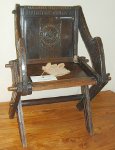

Lionel Smithett Lewis, at St Mark Whitechapel and Glastonbury

Sarah Knowles Bolton, in Our Devoted Friend - the Dog (1902), wrote One of the Committee, Rev. L. S. Lewis, and probably others, believe with John Wesley, Martin Luther, and many more, that there is a future life for animals, as for man. He says, in The Animals' Friend, “Can you believe that a poor creature whose whole life has been made a misery here through no fault of its own will have no compensation hereafter? Can you believe this, and continue in the world?”
| ....The general dreariness and banality... seems to have been only relieved by his concluding statement of a belief that animals not less than man are included in the scope of the Redemption. It is a doctrine which may be commended to the study of theologists; when they have settled it, possibly those who share Mr. Lewis's prejudices might observe with some advantage the general scheme of Nature, note the general preying of animal upon animal, of insect upon insect, and ask themselves whether, apart from physical suffering, the standpoint of nearly all Christian sects is not that we are all here in pursuance of a vast experiment, being sent into the world with free wills, and inoculated at birth with the toxins of good and evil. Unfortunately, however, there are no controls, and the result can never be known to any of us in mundane life. |
| ...The Berlin Antivivisection Society, which consists largely of Protestants, appears to have been somewhat embarrassed by the Papal blessing. There was a discussion among the members whether a compliment which some of them thought might compromise them in a theological sense should be accepted. Another section held stoutly that it was not a matter of creed at all, and that the blessing of the Vatican would be an excellent advertisement for their work. We gather that this business-like view of the case prevailed. We cannot help wondering, however, how the Rev. J. Page Hopps and the Rev. L. S. Lewis feel at having the blessing of the Pope inflicted upon them. Perhaps they may bear it meekly, as being a form of pain inflicted for the good of the sufferer. Another question is, Will the benediction of Pius X serve to bring the various antivivisection societies, which now quarrel with such feminine shrillness, under 'one umbrella'? |
Lewis gave evidence to the Royal Commission on 29 May 1907, representing the Church Anti-Vivisection League. He stated explicitly that he would not have one mouse painfully vivisected to save the greatest of human beings, nor the life dearest to himself. The Commission was set up to consider revision of the 1876 Cruelty to Animals Act (well-named, said the anti-vivisectionsts - it had set up a licensing system for animal experimentation), and was triggered by the Brown Dog affair, when William Bayliss (whose research on dogs led to the discovery of hormones) successfully sued for libel against the charge that a 1903 experiment on a brown terrier had been illegal. In protest, a bronze statue of a dog was erected in Battersea, but was continually vandalised by 'anti-doggers' and need police protection; there were also protest marches. Despite a petition, the Council removed the statue under cover of darkness and it was reputedly melted down. In 1910 the BMJ returned to the offensive and suggested that
| the most appropriate resting place for the rejected work of
art is the Home for Lost Dogs at Battersea, where it could be 'done
to death',
as the inscription says, with a hammer in the presence of Miss
Woodword, the Rev. Lionel S. Lewis, and other friends; if their
feelings were too much for them, doubtless an anaesthetic could be
administered. |
| Now I pass to another category of opponents, who, although I think they adopt an ethical standard which is both irrational and practically unattainable, are, at the same time, much more observing of respect than those to whom I have previously alluded. I take as an example of this category the evidence given before the Royal Commission by a very worthy clergyman, the Rev. Lionel Lewis. I say I respect Mr. Lewis because he has the courage of his opinions, and because those opinions are manifestly the outcome of honest and thoroughly sincere conviction. Mr Lewis was asked the crucial question of whether, supposing a child of his was suffering from diphtheria, he would allow antitoxin to be used, to which he replied in the negative. Would you, he was then asked, let the child die? to which he replied I would. Between those who hold his views and the generality of mankind there is an ethical abyss which it is impossible to bridge over. I fear that little or nothing can be done to influence this category of opinion. |
 When
Lionel Lewis left London to become Vicar of Glastonbury in 1921, the
legends of that emblematic place increasingly absorbed his attention.
In 1922 he published a brief pamphlet about the tradition that Joseph
of Arimathea brought the young Jesus to Glastonbury. He took on board
the story popularised by the Revd Sabine Baring-Gould, in his 1899 Book
of Cornwall, that Joseph had come to England on a trading voyage. Wrong
county (though it's likely that Levantine merchants did come to the
south-west), but Lewis claimed he had also come across a Somersetshire
folksong with some such refrain as 'Joseph was in the tin trade'. By the time of its final edition before his death in 1953 St
Joseph of Arimathea at Glastonbury: or the Apostolic Church of Britain ran to 200 pages with 13 appendices, described as queer
but carefully-documented, and
including the Glastonbury thorn traditions, and consideration of the
claim that the Blessed Virgin Mary was buried at Glastonbury. Other books and pamphlets, including Glastonbury,
the Mother of Saints: Her Saints AD 37 - AD 1539, explored his belief that the Grail
legends had a factual basis, though some are based on psychic revelations.
When
Lionel Lewis left London to become Vicar of Glastonbury in 1921, the
legends of that emblematic place increasingly absorbed his attention.
In 1922 he published a brief pamphlet about the tradition that Joseph
of Arimathea brought the young Jesus to Glastonbury. He took on board
the story popularised by the Revd Sabine Baring-Gould, in his 1899 Book
of Cornwall, that Joseph had come to England on a trading voyage. Wrong
county (though it's likely that Levantine merchants did come to the
south-west), but Lewis claimed he had also come across a Somersetshire
folksong with some such refrain as 'Joseph was in the tin trade'. By the time of its final edition before his death in 1953 St
Joseph of Arimathea at Glastonbury: or the Apostolic Church of Britain ran to 200 pages with 13 appendices, described as queer
but carefully-documented, and
including the Glastonbury thorn traditions, and consideration of the
claim that the Blessed Virgin Mary was buried at Glastonbury. Other books and pamphlets, including Glastonbury,
the Mother of Saints: Her Saints AD 37 - AD 1539, explored his belief that the Grail
legends had a factual basis, though some are based on psychic revelations. Lionel Lewis also acquired
for the parish, after an impassioned plea at its auction, one of two
medieval priests' chairs (the other, at the Bishop's Palace in Wells,
is pictured right): the pattern of the so-called Glastonbury chair has been widely copied by church furnishers over the last century.
Lionel Lewis also acquired
for the parish, after an impassioned plea at its auction, one of two
medieval priests' chairs (the other, at the Bishop's Palace in Wells,
is pictured right): the pattern of the so-called Glastonbury chair has been widely copied by church furnishers over the last century.
Back to St Mark Whitechapel | Back to History